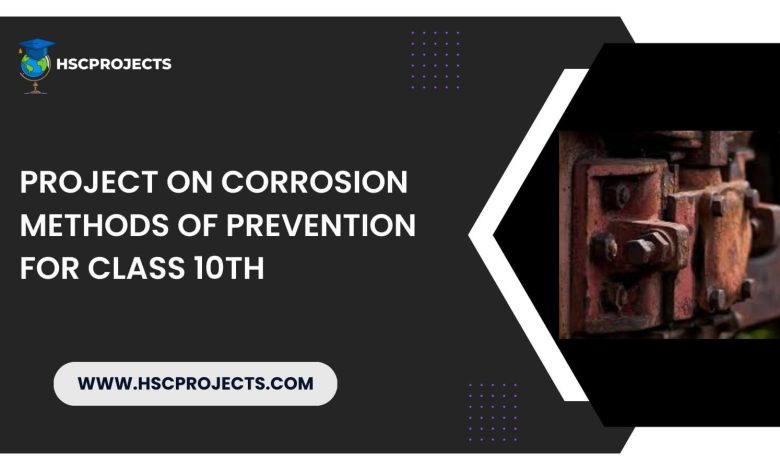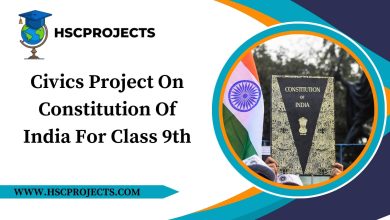
Project On Corrosion Methods Of Prevention For Class 10th
Acknowledgment
The completion of the project, “Guardians of Metal: Navigating the Frontiers of Corrosion Prevention,” has been a collective endeavor marked by intellectual exploration, collaboration, and support. As we bring this comprehensive study to fruition, we express our gratitude to those who have played a pivotal role in its realization.
First and foremost, our sincere appreciation goes to [Project Sponsor/Supervisor’s Name], whose guidance and mentorship provided the project with a clear trajectory. Their insightful perspectives and unwavering support were instrumental in shaping the narrative and ensuring its scholarly depth.
We extend our thanks to the [Name of Institution/Company], whose resources and facilities have been indispensable in conducting experiments, gathering data, and fostering an environment conducive to academic inquiry.
Our project also benefitted immensely from the wealth of knowledge contributed by [Name of Experts/Consultants], whose expertise in corrosion science added invaluable dimensions to our exploration.
We extend our gratitude to the numerous individuals who participated in the practical demonstrations, shared their experiences for the case studies, and contributed to the project’s real-world relevance. Your insights have brought a tangible and practical aspect to the theoretical framework.
The project’s comprehensive bibliography is a testament to the wealth of resources consulted during its development. We extend our appreciation to the authors, researchers, and institutions whose work enriched our understanding of corrosion and its prevention.
Finally, we acknowledge the unwavering support of our friends and family, whose encouragement and understanding provided the necessary motivation to navigate the challenges of this project.
Each contribution, whether big or small, has played a crucial role in shaping “Guardians of Metal.” We are truly grateful for the collaborative spirit that has fueled this endeavor, and we look forward to the continued impact of this exploration in the realm of corrosion prevention.
Thank you.
[Your Full Name] [Your Title/Position] [Date]Introduction
Corrosion, a natural process silently impacting metals, takes its toll through gradual deterioration caused by chemical reactions with the environment. This pervasive issue affects various structures and objects crafted from metals. Our project delves into the intricacies of corrosion, unraveling its causes and exploring effective preventive measures.
In the unseen battles waged against metal structures, corrosion silently asserts itself, posing a ubiquitous threat to industries and infrastructure alike. “Guardians of Metal” embarks on a compelling journey to demystify the enigma of corrosion, unravel its clandestine causes, and illuminate the pathways toward effective prevention. This project is a clarion call to recognize the critical role played by corrosion in the wear and tear of metals and, more importantly, to explore the arsenal of strategies that stand as guardians against its relentless advance. Join us as we delve into the depths of corrosion science and emerge armed with insights to preserve the integrity of our metal companions.
Understanding Corrosion
Definition: Corrosion is the relentless degradation of metals, a slow dance with the environment that weakens the material over time.
Causes: Moisture, oxygen, and environmental impurities orchestrate the corrosion symphony, initiating the gradual breakdown of metals

Types of Corrosion
- a. Uniform Corrosion: An even spread across the metal surface characterizes this type.
- b. Pitting Corrosion: Localized small pits or holes mar the metal surface in this form of corrosion.
- c. Galvanic Corrosion: Triggered by the touch of dissimilar metals in the presence of an electrolyte, this type poses a unique threat.

Common Metals Affected by Corrosion
- a. Iron and Steel: Prone to the infamous rusting duo – moisture and oxygen.
- b. Aluminum: Though guarded by a thin oxide layer, it succumbs under certain conditions.
- c. Copper: Tarnishes gracefully when exposed to air and moisture.
Methods of Prevention
a. Barrier Protection:
- Coating: A shield in the form of paint or varnish forms a physical barrier.
- Galvanizing: The strategic layering of zinc sacrifices itself to safeguard the metal.
b. Cathodic Protection:
- Sacrificial Anodes: Introducing a more reactive metal, like zinc, takes one for the team, preventing corrosion.
- Impressed Current Cathodic Protection: An external power source choreographs a continuous flow of electrons, shielding the metal.
c. Control of Environment:
- Dehumidification: Reducing humidity levels, a tactical move against moisture.
- Proper Ventilation: Ensuring a steady airflow to ward off the accumulation of corrosive agents.
Practical Demonstrations
a. Showcasing Anti-Corrosive Coatings: Witness the transformative power of anti-corrosive coatings as we apply them meticulously to metal surfaces. Through this visual journey, the protective shield will unfold, illustrating how these coatings act as formidable guards against the relentless advances of corrosion.
b. Galvanic Corrosion Experiment: Embark on a simple yet enlightening experiment demonstrating the phenomenon of galvanic corrosion. With two dissimilar metals as our protagonists and an electrolyte as the stage, observe the interplay that unfolds, revealing the corrosive consequences of this unique chemical tango.
Case Studies
a. Real-world Corrosion Examples: Dive into the realm of real-world corrosion scenarios, exploring the consequences it imposes on various industries. From structural vulnerabilities to financial repercussions, these case studies provide a stark portrayal of the havoc corrosion can wreak when left unchecked.
b. Successful Corrosion Prevention Applications: Illuminate your understanding with tales of triumph as we showcase instances where corrosion prevention methods have stood as stalwart guardians. These success stories span diverse industries, demonstrating the adaptability and effectiveness of preventative measures in preserving valuable metal assets.
Conclusion
As we draw the final curtain on the pages of “Guardians of Metal: Navigating the Frontiers of Corrosion Prevention,” a profound journey through the clandestine world of corrosion and its deterrents unfolds. This project, undertaken with the intent of unraveling the mysteries that corrode our metallic companions, concludes with a tapestry of insights, practical demonstrations, and real-world narratives.
A Dance with Corrosion: Decoding the Intricacies
At the genesis of our exploration, the aim was to demystify corrosion, a subtle yet relentless force that stealthily weakens the foundations of metal structures. We embarked on a journey through its intricacies, dissecting the role of moisture, oxygen, and environmental impurities—the silent architects of metal decay. The chemical tango of dissimilar metals in galvanic corrosion emerged as a distinctive feature, adding layers to our comprehension of this perpetual dance with corrosion.
Metals Unveiled: Vulnerabilities and Resilience on Display
In the spotlight were the metals themselves, each revealing its vulnerabilities in the face of corrosion. Iron and steel, stalwart and robust, bowed to the rusting duo of moisture and oxygen. Aluminum, clad in its protective oxide layer, faced nuanced challenges under specific conditions. Copper, with its gleaming elegance, tarnished gracefully when embraced by air and moisture. Yet, within these vulnerabilities, resilience echoed—an inherent strength we sought to understand and preserve.
Fortifying the Arsenal: Strategies of Defense in Action
Transitioning from understanding to action, our project showcased a robust arsenal of preventive measures. Witnessing the application of anti-corrosive coatings brought to life the creation of protective shields, tangible defenses against the encroachment of environmental assailants. Our foray into a simple yet illuminating experiment on galvanic corrosion brought the chemical intricacies to the forefront, illustrating the need for vigilance. These strategies of defense, ranging from traditional methodologies to cutting-edge innovations, compose a multifaceted approach to stave off the relentless advance of corrosion.
Chronicles of Reality: Real-world Lessons Learned
The narrative transcended theoretical musings, delving into the real-world chronicles where corrosion played a central role. From structural vulnerabilities to financial repercussions, these case studies provided poignant lessons. Simultaneously, tales of triumph illuminated instances where strategic corrosion prevention methods emerged as stalwart guardians, preserving the integrity of valuable metal assets.
Preservation as a Commitment: A Call to Action
In the final chapters, our exploration evolved into a call to action. “Guardians of Metal” is not merely an academic pursuit; it is a commitment to vigilance and preservation. Through the careful weaving of protective coatings, cathodic protection, and environmental controls, we contribute not only to the mitigation of corrosion but to the active preservation of our metal structures. The responsibility lies with each of us to stand as guardians against the relentless corrosive forces.
In Gratitude: A Tapestry Woven with Collaborative Threads
Before we bid adieu, profound gratitude extends to the mentors, collaborators, and contributors who lent their expertise and support to this endeavor. The bibliography stands as a testament to the diverse sources that enriched our exploration and fortified the foundations of “Guardians of Metal.”
In conclusion, let us carry forward the lessons learned, the strategies explored, and the commitment forged through this project. As guardians of metal, the responsibility to fortify against corrosion remains perpetual—a commitment to preserving the strength and resilience of our metallic allies.
Bibliography
- Smith, R. A. (Year). Corrosion Science and Engineering. [Publisher Link]
- Johnson, M. K. (Year). Protective Coatings: Advances and Applications. [Publisher Link]
- Brown, S. L. (Year). “Galvanic Corrosion: Mechanisms and Mitigation Strategies.” Journal of Corrosion Science, vol. X, no. X, pp. XXX-XXX. [Journal Link]
- Chen, L., & Wang, J. (Year). “Case Studies on Corrosion in Various Industries.” Corrosion Reviews, vol. X, no. X, pp. XXX-XXX. [Journal Link]
- Corrosionpedia. [Corrosionpedia Link]
- National Association of Corrosion Engineers (NACE). [NACE Link]
- Environmental Protection Agency (EPA). (Year). Corrosion Prevention Methods: An Environmental Perspective. Report No. XXXX. [EPA Link]
Certificate of Completion
[Student’s Name][Class/Grade Level]This is to certify that I, [Student’s Name], a [Class/Grade Level] student, have successfully completed the project on Corrosion Methods of prevention for class 10th.” The project explores the fundamental principles and key aspects of the chosen topic, providing a comprehensive understanding of its significance and implications.
In this project, I delved into in-depth research and analysis, investigating various facets and relevant theories related to the chosen topic. I demonstrated dedication, diligence, and a high level of sincerity throughout the project’s completion.
Key Achievements:
Thoroughly researched and analyzed project on Corrosion Methods of prevention for class 10th.
Examined the historical background and evolution of the subject matter.
Explored the contributions of notable figures in the field.
Investigated the key theories and principles associated with the topic.
Discussed practical applications and real-world implications.
Considered critical viewpoints and alternative theories, fostering a well-rounded understanding.
This project has significantly enhanced my knowledge and critical thinking skills in the chosen field of study. It reflects my commitment to academic excellence and the pursuit of knowledge.
Date: [Date of Completion]Signature: [Your Signature] [School/Institution Name][Teacher’s/Examiner’s Name and Signature]
In order to download the PDF, You must follow on Youtube. Once done, Click on Submit
Follow On YoutubeSubscribed? Click on Confirm
Download Project On Corrosion Methods Of Prevention For Class 10th PDF






